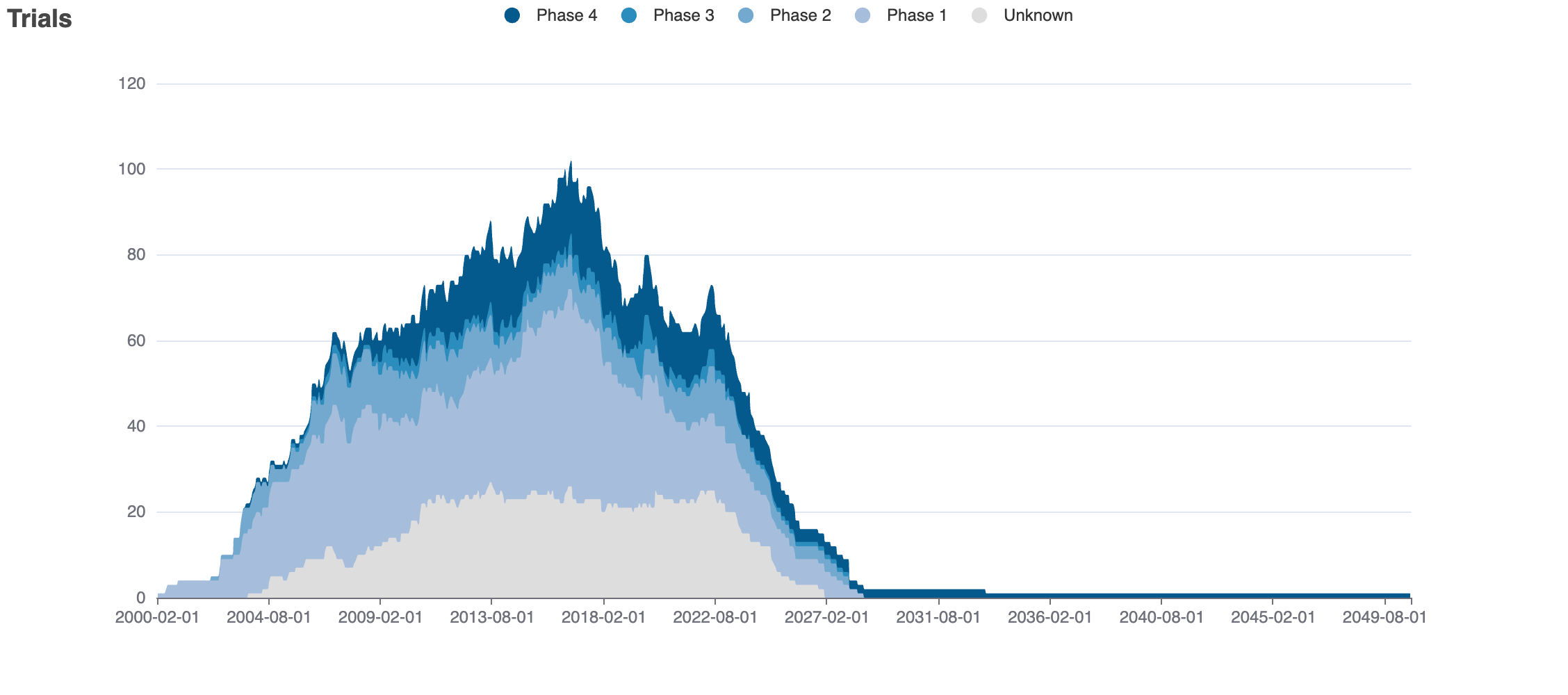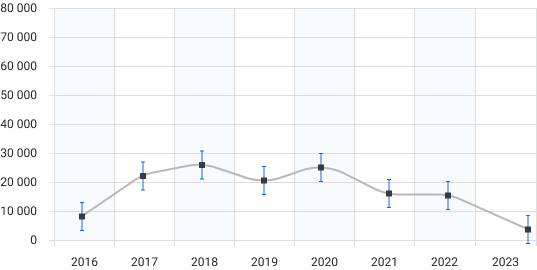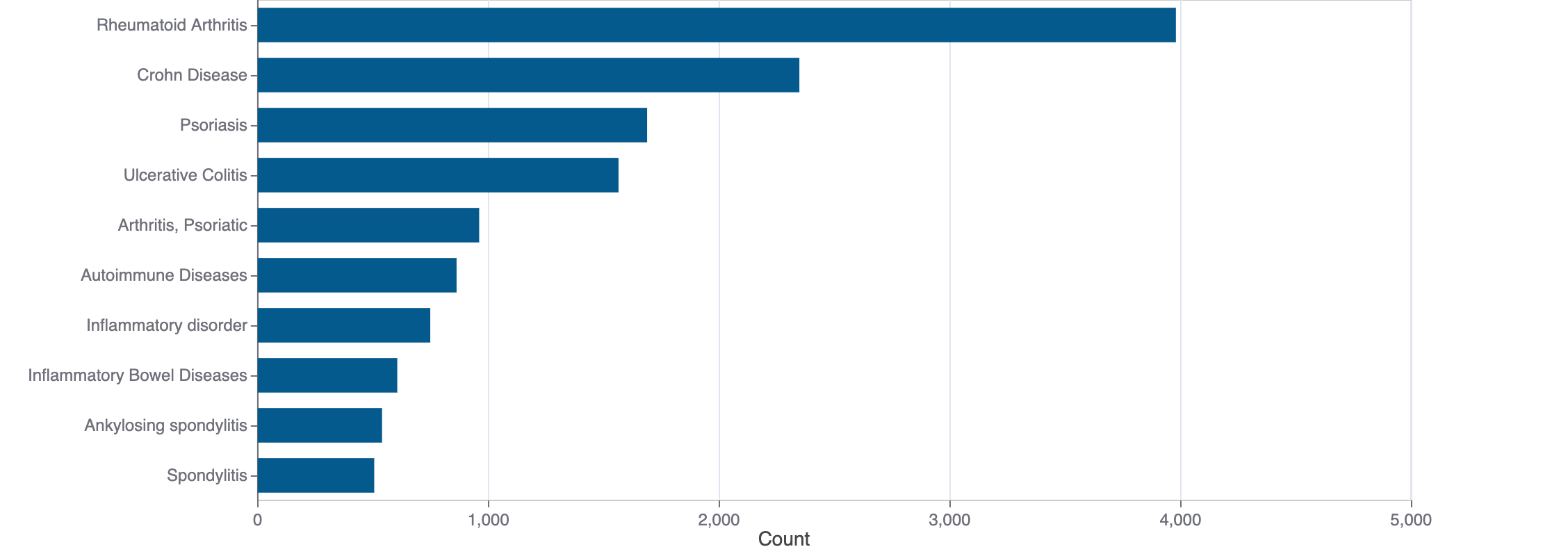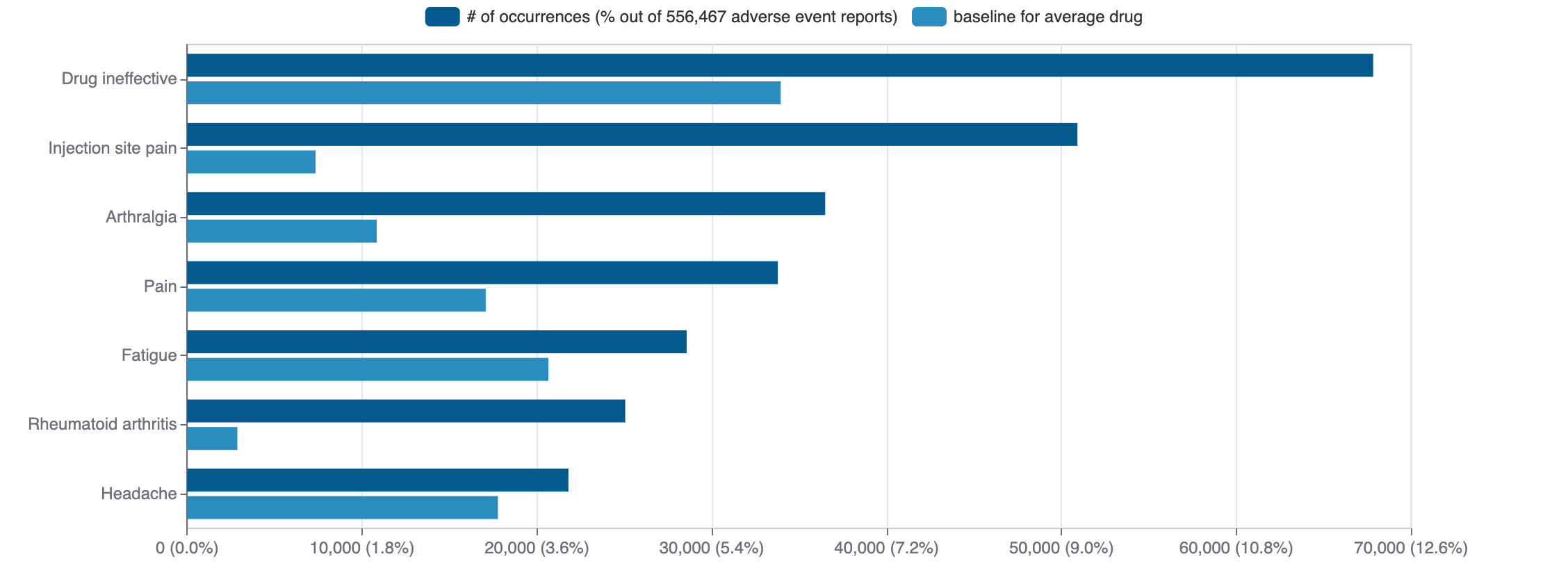Myrbetriq, Betmiga(mirabegron)
Betmiga, Mirabegron, Myrbetriq (mirabegron) is a small molecule pharmaceutical. Mirabegron was first approved as Myrbetriq on 2012-06-28. It is used to treat overactive urinary bladder and urge urinary incontinence in the USA. It has been approved in Europe to treat overactive urinary bladder. The pharmaceutical is active against beta-3 adrenergic receptor. In addition, it is known to target beta-2 adrenergic receptor and beta-1 adrenergic receptor.
Download report
Favorite
Events Timeline
Commercial
Clinical
Drug
Target
Variants
Financial
Trends
Safety
Events Timeline
5D
1M
3M
6M
YTD
1Y
2Y
5Y
Max
Events
FDA approval date
EMA approval date
Patent expiration date
Study first post date
Last update post date
Start date
Primary completion date
Completion date
Results first post date

Mock data
Subscribe for the real data
Subscribe for the real data
Commercial
Therapeutic Areas
Therapeutic Area | MeSH |
|---|---|
| urogenital diseases | D000091642 |
| signs and symptoms pathological conditions | D013568 |
Trade Name
FDA
EMA
Mirabegron, Myrbetriq, Myrbetriq granules (discontinued: Mirabegron)
Drug Products
FDA
EMA
New Drug Application (NDA)
New Drug Application (NDA)
Abbreviated New Drug Application (ANDA)
Abbreviated New Drug Application (ANDA)
Mirabegron
Tradename | Company | Number | Date | Products |
|---|---|---|---|---|
| MYRBETRIQ | Astellas Pharma | N-202611 RX | 2012-06-28 | 2 products, RLD, RS |
| MYRBETRIQ GRANULES | Astellas Pharma | N-213801 RX | 2021-03-25 | 1 products, RLD, RS |
Labels
FDA
EMA
Brand Name | Status | Last Update |
|---|---|---|
| mirabegron | ANDA | 2025-10-02 |
| mirabegron mirabgeorn | ANDA | 2025-10-21 |
| myrbetriq | New Drug Application | 2025-11-06 |
Indications
FDA
EMA
Indication | Ontology | MeSH | ICD-10 |
|---|---|---|---|
| overactive urinary bladder | EFO_1000781 | D053201 | N32.81 |
| urge urinary incontinence | EFO_0006865 | D053202 | N39.41 |
Agency Specific
FDA
EMA
Expiration | Code | ||
|---|---|---|---|
MIRABEGRON, MYRBETRIQ, APGDI | |||
| 2024-09-25 | PED | ||
| 2024-03-25 | I-855 | ||
MIRABEGRON, MYRBETRIQ GRANULES, APGDI | |||
| 2024-09-25 | PED | ||
| 2024-03-25 | NP | ||
HCPCS
No data
Clinical
Clinical Trials
179 clinical trials
View more details

Mock data
Subscribe for the real data
Subscribe for the real data
Indications Phases 4
Indication | MeSH | Ontology | ICD-10 | Ph 1 | Ph 2 | Ph 3 | Ph 4 | Other | Total |
|---|---|---|---|---|---|---|---|---|---|
| Overactive urinary bladder | D053201 | EFO_1000781 | N32.81 | 9 | 10 | 19 | 30 | 25 | 91 |
| Healthy volunteers/patients | — | — | — | 25 | 1 | — | 2 | — | 28 |
| Urinary incontinence | D014549 | — | R32 | 3 | 3 | 9 | 3 | 1 | 17 |
| Urge urinary incontinence | D053202 | EFO_0006865 | N39.41 | — | 1 | 6 | 6 | 3 | 16 |
| Syndrome | D013577 | — | — | — | 1 | 3 | 4 | 2 | 10 |
| Lower urinary tract symptoms | D059411 | EFO_0008008 | — | — | 2 | 1 | 5 | 1 | 9 |
| Prostatic hyperplasia | D011470 | EFO_0000284 | N40 | 1 | 1 | 1 | 3 | 1 | 7 |
| Obesity | D009765 | EFO_0001073 | E66.9 | 2 | 2 | — | 2 | — | 6 |
| Parkinson disease | D010300 | EFO_0002508 | G20 | — | — | — | 4 | — | 4 |
| Prediabetic state | D011236 | EFO_1001121 | R73.03 | 1 | 1 | — | 1 | — | 3 |
Show 14 more
Indications Phases 3
Indication | MeSH | Ontology | ICD-10 | Ph 1 | Ph 2 | Ph 3 | Ph 4 | Other | Total |
|---|---|---|---|---|---|---|---|---|---|
| Urologic diseases | D014570 | — | N39.9 | — | 1 | 4 | — | 2 | 7 |
| Urinary bladder diseases | D001745 | — | N32.9 | — | 1 | 4 | — | 2 | 7 |
| Neurogenic urinary bladder | D001750 | HP_0000011 | N31 | 1 | 2 | 1 | — | — | 3 |
| Heart failure | D006333 | EFO_0003144 | I50 | — | 3 | 1 | — | — | 3 |
| Cystitis | D003556 | EFO_1000025 | N30 | 1 | — | 1 | — | — | 2 |
| Hypertrophy | D006984 | EFO_0002460 | — | — | 1 | 1 | — | — | 2 |
| Ovarian neoplasms | D010051 | EFO_0003893 | C56 | — | 2 | 1 | — | — | 2 |
| Ureteroscopy | D018666 | — | — | — | — | 1 | — | — | 1 |
| Diurnal enuresis | D053207 | — | — | — | — | 1 | — | — | 1 |
| Ovarian epithelial carcinoma | D000077216 | — | — | — | 1 | 1 | — | — | 1 |
Indications Phases 2
Indication | MeSH | Ontology | ICD-10 | Ph 1 | Ph 2 | Ph 3 | Ph 4 | Other | Total |
|---|---|---|---|---|---|---|---|---|---|
| Wounds and injuries | D014947 | — | T14.8 | 1 | 2 | — | — | — | 3 |
| Spinal cord injuries | D013119 | EFO_1001919 | — | 1 | 2 | — | — | — | 3 |
| Neoplasms | D009369 | — | C80 | — | 1 | — | — | 1 | 2 |
| Erectile dysfunction | D007172 | EFO_0004234 | F52.21 | 1 | 2 | — | — | — | 2 |
| Hyperplasia | D006965 | EFO_0000536 | — | — | 1 | — | — | 1 | 2 |
| Thermogenesis | D022722 | — | — | 2 | 2 | — | — | — | 2 |
| Diabetes mellitus | D003920 | EFO_0000400 | E08-E13 | — | 1 | — | — | — | 1 |
| Myeloproliferative disorders | D009196 | — | D47.1 | — | 1 | — | — | — | 1 |
| Essential thrombocythemia | D013920 | — | D47.3 | — | 1 | — | — | — | 1 |
| Polycythemia vera | D011087 | — | D45 | — | 1 | — | — | — | 1 |
Show 33 more
Indications Phases 1
Indication | MeSH | Ontology | ICD-10 | Ph 1 | Ph 2 | Ph 3 | Ph 4 | Other | Total |
|---|---|---|---|---|---|---|---|---|---|
| Pharmacokinetics | D010599 | — | — | 6 | — | — | — | — | 6 |
| Biological availability | D001682 | — | — | 2 | — | — | — | — | 2 |
| Drug interactions | D004347 | — | — | 2 | — | — | — | — | 2 |
| Polycystic ovary syndrome | D011085 | EFO_0000660 | E28.2 | 1 | — | — | — | — | 1 |
| Metabolic syndrome | D024821 | EFO_0000195 | E88.810 | 1 | — | — | — | — | 1 |
| Esophageal achalasia | D004931 | — | K22.0 | 1 | — | — | — | — | 1 |
| Metabolism | D008660 | GO_0008152 | — | 1 | — | — | — | — | 1 |
| Disease | D004194 | EFO_0000408 | R69 | 1 | — | — | — | — | 1 |
| Liver diseases | D008107 | EFO_0001421 | K70-K77 | 1 | — | — | — | — | 1 |
| Intraocular pressure | D007429 | — | — | 1 | — | — | — | — | 1 |
Show 4 more
Indications Without Phase
Indication | MeSH | Ontology | ICD-10 | Ph 1 | Ph 2 | Ph 3 | Ph 4 | Other | Total |
|---|---|---|---|---|---|---|---|---|---|
| Type 2 diabetes mellitus | D003924 | EFO_0001360 | E11 | — | — | — | — | 2 | 2 |
| Sexual behavior | D012725 | — | — | — | — | — | — | 1 | 1 |
| Behavior therapy | D001521 | — | — | — | — | — | — | 1 | 1 |
| Recurrence | D012008 | — | — | — | — | — | — | 1 | 1 |
| Cardiovascular diseases | D002318 | EFO_0000319 | I98 | — | — | — | — | 1 | 1 |
| Nocturnal enuresis | D053206 | — | N39.44 | — | — | — | — | 1 | 1 |
| Deprescriptions | D000069340 | — | — | — | — | — | — | 1 | 1 |
Epidemiology
Epidemiological information for investigational and approved indications
View more details
Drug
General
| Drug common name | Mirabegron |
| INN | mirabegron |
| Description | Mirabegron is a monocarboxylic acid amide obtained by formal condensation of the carboxy group of 2-amino-1,3-thiazol-4-ylacetic acid with the anilino group of (1R)-2-{[2-(4-aminophenyl)ethyl]amino}-1-phenylethanol. Used for the treatment of overactive bladder syndrome. It has a role as a beta-adrenergic agonist. It is a member of 1,3-thiazoles, an aromatic amide, a member of ethanolamines and a monocarboxylic acid amide. |
| Classification | Small molecule |
| Drug class | beta3 adrenoreceptor agonists |
| Image (chem structure or protein) |  |
| Structure (InChI/SMILES or Protein Sequence) | Nc1nc(CC(=O)Nc2ccc(CCNC[C@H](O)c3ccccc3)cc2)cs1 |
Identifiers
| PDB | — |
| CAS-ID | 223673-61-8 |
| RxCUI | — |
| ChEMBL ID | CHEMBL2095212 |
| ChEBI ID | 65349 |
| PubChem CID | 9865528 |
| DrugBank | DB08893 |
| UNII ID | MVR3JL3B2V (ChemIDplus, GSRS) |
Target
Agency Approved
Alternate
ADRB2
ADRB2
ADRB1
ADRB1
Organism
Homo sapiens
Gene name
ADRB2
Gene synonyms
ADRB2R, B2AR
NCBI Gene ID
Protein name
beta-2 adrenergic receptor
Protein synonyms
adrenergic, beta-2-, receptor, surface, adrenoceptor beta 2 surface, Beta-2 adrenoceptor, Beta-2 adrenoreceptor, catecholamine receptor
Uniprot ID
Mouse ortholog
Adrb2 (11555)
beta-2 adrenergic receptor (Q8BH38)
Variants
No data
Financial
Revenue by drug
$
€
£
₣
No data
Estimated US medical usage
Mirabegron
Total medical expenditures per year (USD, in millions)

Mock data
Subscribe for the real data
Subscribe for the real data
Number of persons purchased

Mock data
Subscribe for the real data
Subscribe for the real data
Number of purchases

Mock data
Subscribe for the real data
Subscribe for the real data
Refill frequency

Mock data
Subscribe for the real data
Subscribe for the real data
Price per prescription (USD)

Mock data
Subscribe for the real data
Subscribe for the real data
Tabular view
Trends
PubMed Central
Top Terms for Disease or Syndrome:

Mock data
Subscribe for the real data
Subscribe for the real data
Additional graphs summarizing 2,390 documents
View more details
Safety
Black-box Warning
No Black-box warning
Adverse Events
Top Adverse Reactions

Mock data
Subscribe for the real data
Subscribe for the real data
24,539 adverse events reported
View more details
© 2020-2025 Collaborative Drug Discovery Inc. (CDD) | Terms of Use